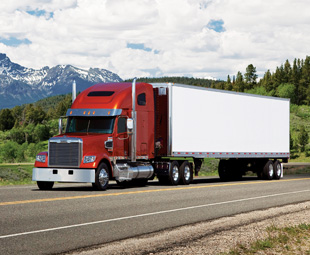Volvo’s global engine family spreads

For the inside track on where some of the world’s leading manufacturers are deciding to position their manufacturing capacity look no further than FRANK BEETON’S insightful overview this month.
In last month’s Global FOCUS, we added a dose of our own (hopefully informed) speculation to recent news reports, to suggest some outcomes for the smaller engine component of the Volvo Group’s Common Architecture Shared Technology strategy. This followed on from the launch announcement of UD Trucks Corporation’s new Condor PK truck and its seven-litre displacement GH7 engine, both of which are scheduled to enter the Japanese and export markets later this year. We also harked back to May’s announcement that the Group will bring its Euro 6-compliant medium duty five to eight-litre diesel engines “in house” from 2013, to replace the current Deutz-built units used in Volvo and Renault’s mid-sized truck ranges.
Hardly was the ink dry on that article when the next link in the chain clanged noisily into place. Somewhat surprisingly, this news came from India, where VE Commercial Vehicles (the Volvo-Eicher joint venture established in 2008) announced the investment of $US60 million in preparations to build the Volvo Group’s “new global medium-duty engine” in India. VECV already manufactures around 40 000 engines per annum in its Pithampur facility, and it is to use its established local supplier base and purchasing channels to gear up for the production of an additional 85 000 Volvo Group medium duty base engines. This annual quantum certainly suggests that the Indian operation will form an integral component of the global production programme for these engines, and this has been confirmed in Volvo’s announcement of their plans. Other production and assembly facilities involved with the “medium engine” will be located at Venissieux in France, and, as reported last month, Ageo in Japan.
The release states that the development process for this new engine will be led by Volvo Powertrain in Ageo, Japan, which gives a clear indication of the level of integration of UD (formerly Nissan Diesel) into the Group. The Pithampur facility will carry out final assembly of Indian market engines, as well as those built for worldwide Euro 3 and Euro 4 applications. Japanese market engines will be manufactured at Ageo, while European market power units will be assembled at Venissieux, presumably using components sourced from India. More detail has also been revealed about this engine “family”, which will be made up of five-, seven- and eight-litre displacement units, developing outputs ranging from 160 to 260 kW (215 to 350 hp), and complying with Japanese PNLT, US EPA 2010 and Euro 3 to 6 emission standards.
The choice of India as a mainstream production base for this engine family tells us a great deal about Volvo’s future strategic direction. The company clearly recognises the importance of competitive production costs, and this announcement also confirms that expectations of world-class quality from Indian manufacturing operations are becoming deeply entrenched among the global manufacturing families. Start of production at Ageo is clearly imminent, given last month’s report, while engine build at Phithampur is scheduled to commence in 2012.
The mention of US EPA 2010 compliance is also interesting, as the Group’s current activities on the North American continent with both the Volvo and Mack brands are heavily focused towards tandem-drive heavyweights. The availability of a legally compliant mid-size diesel may well suggest growing interest in the lighter mass categories, where UD does have a presence with its cabover (forward control) range in Classes 4-7 (GVM ratings from 6.4 to 15 t), but has to work hard to sell these products to a market with a clear preference for conventional (bonneted) models. Ambitions of increased success in this market area may well necessitate the fairly early development of a dedicated “conventional” long-nosed truck, along the lines of Hino’s “North American Project” (NAP) truck range which launched in 2004.
Hino had conducted a five-year design and development exercise, recognising US operator preference for “conventional” distribution trucks and standardised driveline components. The result was a six-model conventional medium truck range using a cab adapted from the contemporary forward-control 500 Series cruiserweight series. The “add-on” bonnet was designed to rake down steeply from the windscreen and provide good forward vision, ending in an aggressive-looking, horizontally-slatted grille. Other specific features for the North American market included a huck-bolted 864 mm wide chassis frame; a selection of driveline and undercarriage components from Meritor, Hendrickson, Allison, Dana and Eaton; and GVM ratings spanning the spectrum from 7 to 15 t. This exercise proved successful, and it is notable that one of the latest models to stem from the NAP exercise, the Hino 338, was declared “Medium Duty Truck of the Year” at the 2010 Mid America Trucking Show.
It will be interesting to see if UD intends to do something similar with its new Condor PK Series cab!
Mercedes-Benz Surprises with additional Actros Production in Turkey and Brazil
When Global FOCUS reported on the launch of the third generation Mercedes-Benz Actros in 2008, we expressed the opinion that this was likely to be the last major revision to this distinguished product line. There were two rational reasons for supposing this; firstly, the basic Actros design dates back almost a decade-and-a-half, and, secondly, Daimler Trucks is now very publicly committed to the use of its Heavy Duty Engine Platform (HDEP) global family of power units for all new models going forward (Recent Stateside reports suggest good early market acceptance of the Detroit Diesel DD15 and DD13 members of this family). Conventional wisdom tells us that a tru ck designed very tightly around Mercedes’ OM 500 series of low and wide V-6 and V-8 diesels will require fairly radical repackaging to accept the longer and taller six-in-line configuration adopted by the HDEP range. For example, the shape of the sheet metal making up the cab floor will need to take on a different set of contours if the usual objectives of minimal frontal area and convenient crew access are to be achieved, and there could also be implications for the shape of the chassis rails up front.
ck designed very tightly around Mercedes’ OM 500 series of low and wide V-6 and V-8 diesels will require fairly radical repackaging to accept the longer and taller six-in-line configuration adopted by the HDEP range. For example, the shape of the sheet metal making up the cab floor will need to take on a different set of contours if the usual objectives of minimal frontal area and convenient crew access are to be achieved, and there could also be implications for the shape of the chassis rails up front.
With these sort of fundamental changes in view, all the accumulated experience gained with Actros during its pre-launch development, and countless millions of kilometers chalked up by operators since 1996, it seemed logical that an all-new design – off a clean sheet of paper – might not be far off, and that a launch opportunity could well present with the introduction of Euro 6 emission standards in January 2013.
With the foregoing as background, we were somewhat surprised to read recently that production of the current Actros model is to be started in Brazil and Turkey, which will become additional sources to the Wörth plant in Germany, where more than half-a-million units have been built to-date. We found this surprising because it seems late in the life of this model to be expanding its production base, and doubly surprising because Mercedes-Benz’ heavy-duty truck business in both Brazil and Turkey has recently been geared to the more basic Axor product line. In Brazil, there is also the even more parochial Linha Tradicional range of semi-forward control models, which elicit memories of trucks last seen in the 1970s. However, with the announcement of the new Actros arrangement, Mercedes-Benz has made it quite clear that the demand for trucks in general, and premium heavy-duty long-haul trucks in particular, has been developing in both Turkey and Brazil. So there is obviously no point in waiting for a new model to arrive before fully confronting competition from the likes of Scania, Volvo and MAN in these markets.
The Turkish arrangement will see Actros truck-tractor and construction models entering the local market towards the end of 2010. They will be assembled from kits, originating in Wörth, at the Askaray plant of Mercedes-Benz Türk, alongside Atego, Axor and Unimog models. This plant has also been slated for the production of export Actros units. In Brazil, truck production is to commence at the Juiz de Fora passenger car production site in Minas Gerais during 2011, where Actros is to be built alongside the unique Brazilian Accelo light truck model. Brazil is Mercedes-Benz’ largest truck market, with 18 047 units sold in the January-May 2010 period, and production capacity at the original São Bernado do Campo facility is forecast to be fully utilized by 2012.
Mid America Trucking Show
The 2010 Mid America Trucking Show (MATS) was held earlier this year in Louisville, Kentucky, a town which was once the production home of the range of Ford heavy-duty trucks that were a common sight on American and South African highways. In 1997, the whole operation was sold to Daimler, who placed it under Freightliner control and renamed it “Sterling”. Its subsequent progress and ultimate demise have been comprehensively documented in Global FOCUS. However, the show goes on, and has become the most important single window into the American truck industry, with its continuing retention of anachronistic features such as conventional cabs across the board and petrol-engines in light trucks. Here are some highlights from this year’s exhibition:
• Kenworth introduced its new T700 premium hauler with Aerodyne sleeper cab at MATS. Intended to replace the groundbreaking T2000 that has been in production since 1996, the T700 consolidates the development lessons learned from its aerospace technology-inspired predecessor, and visual changes are apparent in the moulded bonnet, cab roof and side skirts. This model will offer Paccar’s own DAF-derived 12.9 litre MX power unit in ratings from 285 to 360 kW (380 to 485 hp) in addition to the more usual Cummins options. Kenworth also launched its T440 natural gas powered truck at the show. This uses the Cummins Westport ISL G engine which develops
240 kW (320 hp), and can be specified as a Class 7 vehicle at 15 t GVM, or a Class 8 unit at 31 t all-up mass.
• Paccar stablemate Peterbilt also had a new premium tractor on show – the 587. Developed from the earlier 387 model, this was seen as being an equivalent step to Kenworth’s T2000/T700 progression, with mainly cosmetic and aerodynamic refinements. The 587 also offers the choice of Paccar MX or Cummins ISX15 power units. Peterbilt also announced production start-up of its Model 328 Hybrid refuse truck. This is a low cab-forward model using Eaton Hydraulic Launch Assist, which captures braking energy as pressurised hydraulic fluid and uses it to enhance acceleration.
• Mack was the sole representative of the Volvo family at Louisville, showing off its mDRIVE 12-speed automated mechanical transmission, featuring the cleverly named Grade Gripper (hill start assist) and MackCellerator kick-down options. Mack also launched new Econodyne software for its MP7 and MP8 engines, which provides a torque boost at full engine load to minimise downshifts.
• Daimler Trucks North America’s exhibits were mainly concerned with some reshuffling of the Freightliner and Western Star line-ups, and the announcement that the former’s Classic XL has now been discontinued, and replaced by the Century Class-based Coronado. Western Star has shed responsibility for the discontinued Sterling range, and now has its own dedicated marketing and engineering staff.
Global FOCUS is a monthly update of international news relating to the commercial vehicle industry. It is compiled exclusively for FOCUS by Frank
Published by
Focus on Transport
focusmagsa



